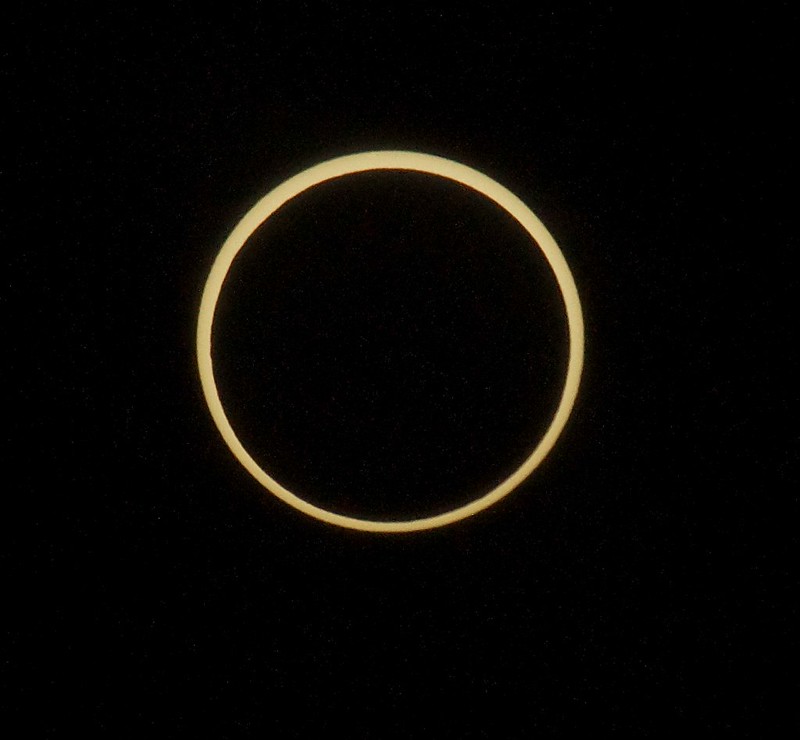Yesterday there was an annular solar eclipse--that is, one in which the moon's apparent diameter is not quite large enough to completely block the sun. In contrast to a total solar eclipse, a thin ring of sunlight remains visible at the time of maximum coverage, and we don't get to see the sun's corona. This, in turn, comes from the fact that solar eclipses always occur at the time of the new moon, and this month's new moon is smaller in apparent diameter than usual. And that follows naturally from the fact that at the time of the full moon fifteen days ago, the moon was correspondingly closer with a bigger apparent diameter.
This is one of the key aspects of science. The chain of cause and effect can go on and on.
Here in Los Angeles, we were outside the path of annularity, but still were treated to our finest partial solar eclipse in two generations. The pictures that follow were taken with a 12-megapixel digital camera and at full zoom except where otherwise noted. The location was downtown Culver City for the first several photos, which were taken through a solar filter held in front of the camera lens. This filter is just like the dark yellow-green welding glass astronomers advised people to use, but smaller and designed to fit over a telescope eyepiece.
 |
| The Eclipse Begins |
About twenty minutes later the next picture was taken.
 | |||||||
| A Bigger Bite |
At this point, the usual late afternoon haze, for which all the Westside is notorious, began to move in. This didn't bode well, so we decided to head home, a few minutes' drive distant, to continue our observations there and see if we could still capture anything worthwhile.
Actually, that thin layer of cloud was the best thing that could have happened, because that made it possible to continue shooting without the filter. Here is the first of these pictures.
 | ||||||
| Approaching maximum occultation |
In the pictures that follow, we can observe two things. First, the crescent-like area of sunlight gets thinner, and secondly that shape swings around counterclockwise, as the moon's position in the sky was slightly higher than the sun's.
 |
| Later, a little closer to max occultation |
The next photo must have been right around the instant of maximum occultation. It is difficult to be sure, though, because as luck would have it, the camera's calendar-clock was about a day behind. Not a whole, exact, single day, mind you, because that would have been too easy. Instead, we're talking about twenty-three hours "and change", as the expression goes.
 |
| At Maximum Occultation |
To close this out, we present the following wide shot. As in the previous photographs, the mostly obscured sun is unable to overcome what must have really been a mere thin haze. This also demonstrates clearly how even a partial eclipse can result in a very significant darkening effect, given sufficiently great occultation by the moon. Recalling that this picture was taken without any kind of filter, it is remarkable how wan the light of this remaining sliver of sun is. Under normal circumstances, too, some color in the trees and houses would still be evident, but the light here was too dim for that to register.
 | |
| Wide Shot, Shortly After Maximum |
Also evident here is how the "crescent" has swung around, so to speak, in comparison with earlier views; there the points of the "crescent" were aimed to the observer's right and slightly upward. Here they point nearly straight up, like the bow and stern of some exotic boat.
All these shots were cropped from the originals for inclusion here. Anyone who is interested may see the originals in our Flickr stream here. In addition to the fact that those pictures are un-cropped, there are several more that were omitted from this post.
All these shots were cropped from the originals for inclusion here. Anyone who is interested may see the originals in our Flickr stream here. In addition to the fact that those pictures are un-cropped, there are several more that were omitted from this post.
Addendum 2012-05-24
Although we were unable to see the full effect of annularity, it seems only proper to provide an illustration of it. Our thanks go out to our friend beowulff, of the Straight Dope Message Board community, who did his observing at Sandia Peak, NM, and graciously consented to the use of his photograph, below.
 |
| Full Annularity, As Visible from Sandia Peak, NM |
We are also indebted to another member of the SDMB, who prefers to remain uncredited but has allowed us the use of the following photo showing what we might as well call the pinhole effect. In the absence of an adequate viewing filter, amateur observers are usually advised to use a pinhole in a sheet of thin cardboard, which projects the partially eclipsed Sun's image onto the ground or another sheet. As it turns out, when the light of the Sun shines through a tree, the apertures between the leaves can also act as pinholes, and result in the projection of hundreds of individual images beyond the tree, as shown in this photograph.
 |
| Numerous Projected Images Created By Sunlight Passing Through A Tree |
No comments:
Post a Comment